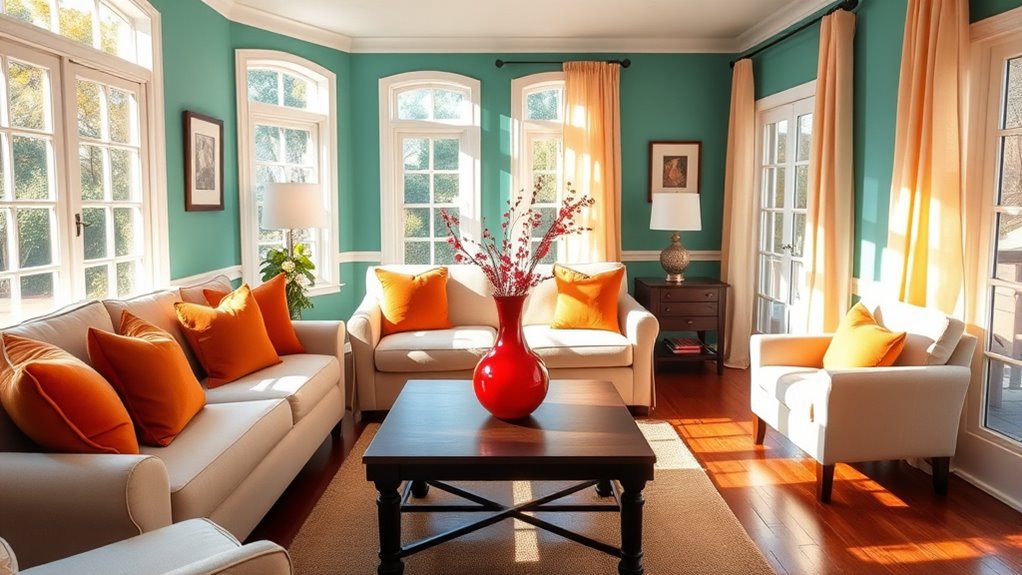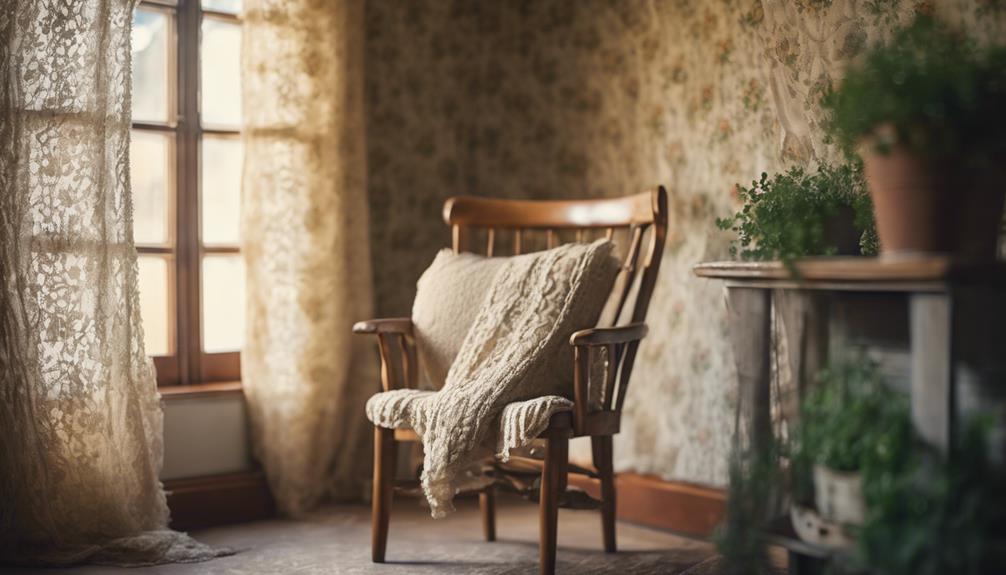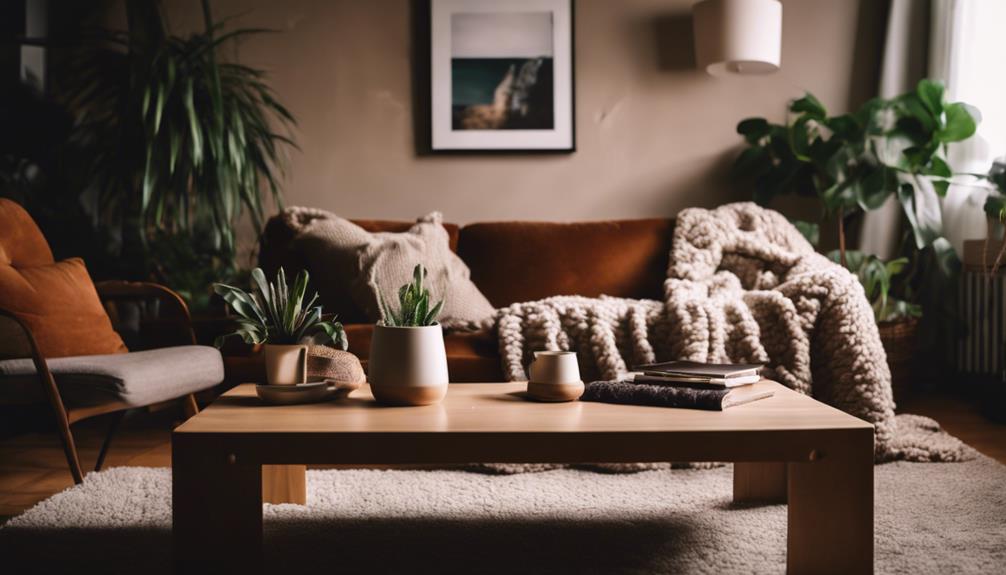Color psychology can profoundly influence your home’s atmosphere and your mood. By choosing specific hues for walls, furniture, or accents, you can promote feelings of relaxation, happiness, or motivation. Bright colors like yellow energize, while softer shades like pastels help you unwind. Recognize how colors carry different meanings and suit your personal symbolism to create a space that supports your well-being. Continue exploring to discover how to select the perfect palette for your environment.
Key Takeaways
- Colors influence mood and emotional well-being, so choosing hues aligned with desired feelings enhances home atmosphere.
- Bright colors like yellow boost happiness, while softer pastels promote relaxation and stress reduction.
- Understanding cultural and personal color symbolism ensures décor choices resonate meaningfully with inhabitants.
- Thoughtful color selection can energize or calm spaces, supporting mental health and overall comfort.
- Intentional use of colors transforms homes into personalized environments that reflect personality and promote well-being.

Color plays a powerful role in shaping the atmosphere of your home, influencing your mood and overall well-being without you even realizing it. When you choose specific hues for your walls, furniture, or accents, you’re not just decorating—you’re setting the tone for how you feel in each space. Understanding color symbolism and the psychological effects of color can help you create environments that promote relaxation, motivation, or comfort, depending on your needs. For example, blue often symbolizes calmness and stability, making it a popular choice for bedrooms or workspaces where focus and serenity are desired. On the other hand, warm colors like red and orange evoke energy and passion, perfect for social areas or kitchens where you want an inviting, lively atmosphere.
Color influences your home’s mood, fostering relaxation, energy, or tranquility through mindful choices.
The psychological effects of color extend beyond mere symbolism; they directly influence your emotional state. Bright yellows can lift your spirits and foster feelings of happiness and optimism, while softer pastel shades can promote relaxation and reduce stress. When you pick colors for your living space, think about the mood you want to cultivate. A vibrant red accent wall might energize a room, but it can also increase feelings of agitation if overused. Conversely, muted tones like taupe or sage can provide a calming backdrop that encourages tranquility and mindfulness. Recognizing these effects allows you to make more intentional choices that support your mental health and daily routines. Additionally, selecting colors that align with color symbolism can enhance the overall harmony of your décor.
Color symbolism varies across cultures and personal experiences, so it’s essential to select hues that resonate with you. If you associate green with growth and renewal, incorporating it into your home can foster a sense of freshness and vitality. If purple symbolizes luxury and creativity in your eyes, using it in a home office or meditation space might enhance your inspiration and focus. The key is to understand how different colors impact you personally and how they align with the ambiance you want to create. When you’re mindful of these connections, your décor choices become more meaningful and effective.
Ultimately, the interplay between color symbolism and the psychological effects of color empowers you to craft a home environment that reflects your personality and supports your well-being. Whether you aim for a peaceful retreat or an energetic hub, selecting the right hues can make all the difference. By consciously considering how colors influence mood and behavior, you turn your home into a sanctuary tailored to your emotional needs, enhancing both your comfort and your overall quality of life.
Frequently Asked Questions
How Do Cultural Differences Affect Color Perception in Home Décor?
Cultural differences considerably influence how you perceive color in home décor. Cultural symbolism shapes your color preferences, with some hues representing luck, spirituality, or status in different societies. For example, red might symbolize good fortune in Chinese culture but signify danger elsewhere. Your choices are often rooted in these cultural meanings, guiding how you select colors to create a space that resonates personally and culturally.
Can Color Psychology Influence Mood Over Long-Term Home Residency?
You might think mood changes are short-lived, but long-term emotional effects from your home’s colors are real. Consistent color schemes can create a calming, uplifting environment that influences your daily feelings. By applying color consistency strategies, you reinforce positive mood patterns over time. Adjusting your décor thoughtfully ensures your space continues to support your well-being, making your home a true sanctuary for your emotional health.
Are There Specific Colors Recommended for Small or Crowded Spaces?
In small or crowded spaces, you should choose color schemes that enhance spatial perception, making the area feel more open. Light, neutral colors like soft whites, beiges, or pastels reflect more light and create an airy feel. Avoid dark or overly bold colors that can make the space feel cramped. Using strategic color choices can visually expand your space and improve its overall ambiance, making it more comfortable and inviting.
How Does Lighting Impact the Psychological Effects of Colors in a Room?
Think of lighting ambiance and color temperature as the sun’s mood—bright and energetic or soft and calming. In a room, your lighting can amplify or soften color effects; warm tones create cozy spaces, while cool tones promote alertness. For example, a warm-colored wall under soft lighting might feel inviting, but harsh fluorescent lighting can dull its warmth. Your lighting choices shape how colors influence your mood daily.
Can Color Choices in Home Décor Affect Sleep Quality?
You might notice that your color choices in your sleep environment can affect your sleep quality. Softer, cooler colors like blues and greens tend to promote relaxation, helping you fall asleep faster. Warmer colors or overly bright hues can be stimulating, making it harder to rest. Pay attention to color temperature, opting for calming shades that create a peaceful atmosphere, which can improve your overall sleep experience.
Conclusion
Just as Da Vinci understood the power of color to evoke emotion, your décor choices shape your space’s mood and energy. By selecting hues intentionally, you wield the brush that paints your environment’s personality. Remember, the colors you surround yourself with aren’t just aesthetic—they’re a reflection of your inner world, much like an artist’s masterpiece. So, choose wisely, and let your home tell the story of your own vibrant, harmonious life.









